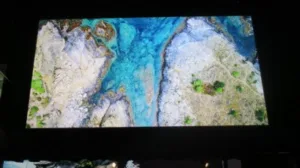The big NEC news from ISE was the acquisition of S[quadrat], the German LED video wall manufacturer, the day before ISE began and reported in the February 9th issue of LDM. (NEC Acquires German LED Solution Provider S[quadrat]) The relationship between NEC and S[quadrat] is not new because over the past three years NEC has successfully promoted the S[quadrat] product portfolio across all major markets.
We discussed this acquisition with a NEC and S[quadrat] reps in the NEC booth at ISE and they said the main reason for the acquisition was to complete NEC’s product portfolio. NEC is a major player in both projection and direct-view LCD displays. By adding S[quadrat]’s LED videowall technology, it can now offer its customers a large-screen display solution whether they want projection, single or tiled LCD or direct view LED. I was told that NEC will maintain the S[quadrat] R&D facility in Germany for the time being and continue to use the S[quadrat]-owned manufacturing facility in Shenzhen, China.
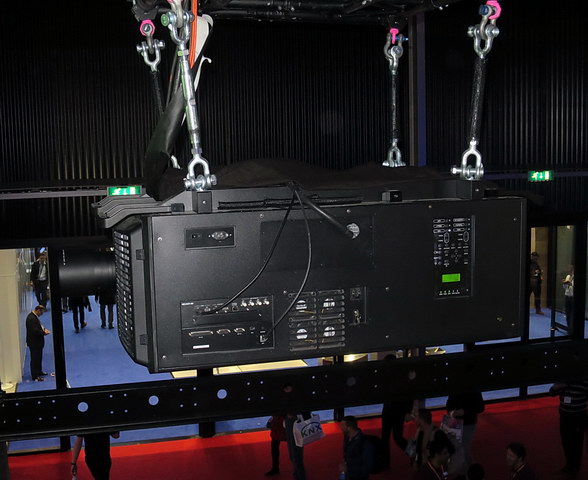 NEC PH3501QL projector in the NEC booth at ISE. (Credit: M. Brennesholtz)
NEC PH3501QL projector in the NEC booth at ISE. (Credit: M. Brennesholtz)
NEC introduced two new projectors at ISE. First was the PH3501QL and its companion, the PH2601QL. The PH3501QL is a 3-chip DLP (1.38″ DMDs) projector with true 4K native resolution (4096 x 2160). The projector does not use pixel shift to achieve the 4K resolution. It uses what NEC calls RB Laser technology, i.e. it uses red and blue lasers plus a blue laser pumped green phosphor. (We have been promised a more detailed look at this technology – Man. Ed.) This is said to not only dramatically lower the cost compared to a pure RGB laser but it also makes the projector more compact. Output is 40,000 center lumens of 35,000 ANSI lumens. Contrast is 30,000:1 with dynamic contrast. Lifetime for the light source is said to be 20,000 hours. The projector has a ±50% vertical lens shift and there are three new-design lenses to fit the unit.
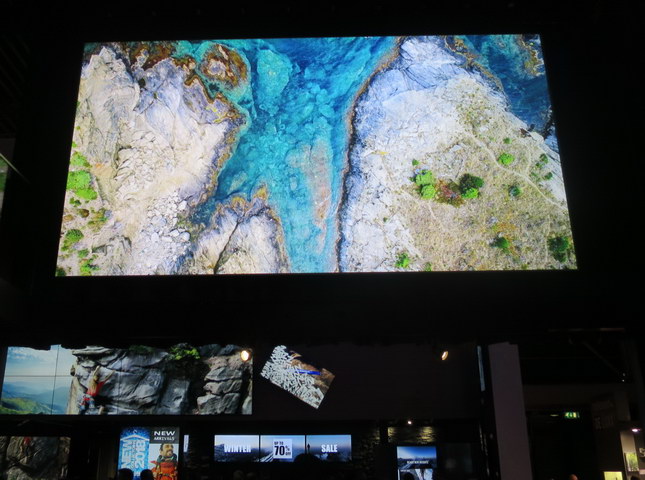 Image (at top) produced by the NEC PH3501QL projector dwarfed most of the other images in the booth at ISE. (Credit: M. Brennesholtz
Image (at top) produced by the NEC PH3501QL projector dwarfed most of the other images in the booth at ISE. (Credit: M. Brennesholtz
The color gamut is said to be larger than DCI/P3 and the projector will decode Rec. 2020 and HDR-10 encoded signals from all inputs. In addition to a variety or normal inputs, there is an Open Pluggable Specification (OPS) slot for additional inputs or an internal media player. The projector comes with a five year parts and labor warranty with the first year of NEC Instacare Service at no additional charge. MSRP is $149,999, according to the website but I was told it was €150K at ISE.
The PH2601QL is said to be the “little sister” to the PH3501QL, with the same basic specifications and physical size except it produces 30,000 center lumens. MSRP for this projector is $129,999. Not so little but still a lot less than the €350K or so that a similar RGB laser projector would cost.
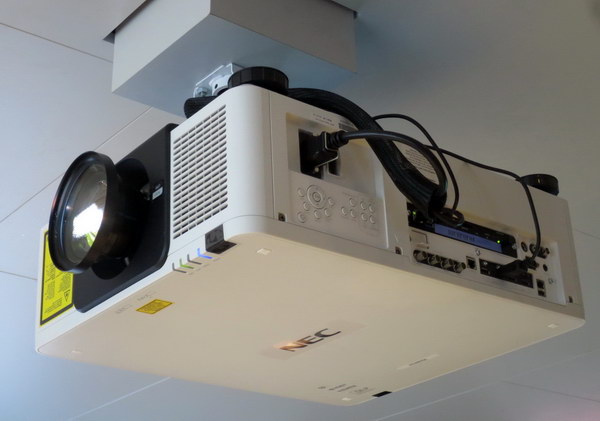 The NEC PX1005QL was launched at ISE. (Credit: M. Brennesholtz)
The NEC PX1005QL was launched at ISE. (Credit: M. Brennesholtz)
The second new projector launched at ISE was the PX1005QL projector with 10K ANSI lumens output. This projector achieves UHD resolution (3840 x 2160) resolution using a single-chip DLP design and pixel-shift technology. The projector has a variety of UHD inputs including quad 3G SDI inputs and an OPS slot. This unit uses ‘conventional’ laser-phosphor technology with blue lasers and phosphors to produce red and green. The light source has a 20,000 hour life. The projector has no filters at all and no scheduled maintenance. Install the projector and come back 20,000 hours later (2.3 years of 24/7 operation) and the projector should still be operating normally.
According to NEC, this projector falls into photobiological Risk Group 2, while some other 10K lumen projectors fall into Risk Group 3. The benefit of being in Risk Group 2 vs group 3 is simpler safety rules for installation of the projector in Europe. I was not familiar with the IEC standard that defined Risk Groups and found on-line a Digital Projection document that give a simple explanation of the standard. See the DP story in this special ISE report for a complete explanation of photobiological risk groups. (Digital Projection Shows 8K Projector)
 Rear and front of a tile of five LED LiFT displays from NEC at ISE. (Credit: M. Brennesholtz)
Rear and front of a tile of five LED LiFT displays from NEC at ISE. (Credit: M. Brennesholtz)
NEC, like many others at ISE, showed a poster display, using the NEC/S[quadrat] LED LiFT-L015Si tiles. A poster display is typically a tall narrow direct-view LED display intended to replace paper posters, especially in retail stores. These tiles were packaged into a complete poster display system that had a pixel pitch of 1.5mm and 800 nits of brightness. Each unit was 1.9M tall and 0.57M wide that weighed 30Kg. Each poster display contained a media player that could be controlled by a mobile app. In addition, the displays had HDMI input. These units are intended to be complete systems and can be moved around the store as needed. They can be used alone or tiled side-by-side, as was done by NEC at ISE. Poster displays, including the NEC unit, are typically only usable indoors. The NEC poster display itself is a prototype and is expected to be available by the end of 2018 or early 2019. The LED LiFT tile itself is not a new product and was introduced at InfoComm 2016.
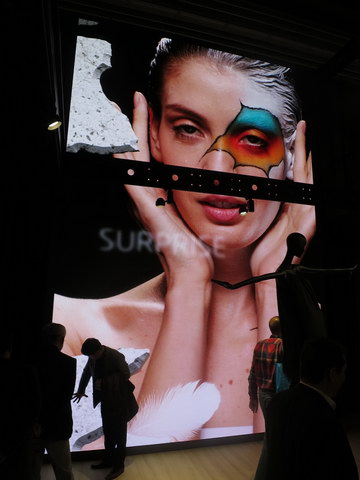 Large S[quadrat] LED display in the NEC booth with a 2.8mm pitch. (Credit: M. Brennesholtz)
Large S[quadrat] LED display in the NEC booth with a 2.8mm pitch. (Credit: M. Brennesholtz)
Jasmin Stemmler, Marketing Director at NEC Display Solutions Europe, explained to me about the S[quadrat] LED displays in the NEC booth. Several were being shown, including a large one with a 2.8mm pitch, a 1.9mm pitch poster display and a 1.2mm pitch unit intended for conference room use. The large display, 6M high by 4M wide, in the NEC booth was one of these units with a 2.8mm pitch
She explained that S[quadrat] had a 3.9mm pitch unit that was ideal for transit applications. This unit was Class B in terms of EMI emissions in sizes up to 40 M2 and Class B was a requirement for airports and train stations. Some competitor units are Class A and cannot be used within 2Km of airports.
Other new displays shown in the NEC booth at ISE included:
- Context aware shelf display from NEC R&D. This unit was also made from the LED LiFT-L015Si tiles. It had a display behind a set of shelves for a retail store. Sensors determined what the customer was interested in and displayed the appropriate information.
- NEC Infinity boards with 65” and 85” diagonals. These 1080p displays are intended to be used in video conferencing and other collaboration applications.
- A UHD display made from 1.2mm pitch LED LiFT-L012Si LED tiles. This high-resolution 800 nit display is designed for indoor applications such as viewing Big Data.
S[quadrat] Booth
 S[quadrat] Ocean Series display with a 3.9mm pitch. (Credit: M/ Brennesholtz)
S[quadrat] Ocean Series display with a 3.9mm pitch. (Credit: M/ Brennesholtz)
S[quadrat] also had it’s own booth, which I visited while at ISE. Again the big news was the acquisition by NEC. They were also showing a new product, the Ocean Series of LED displays. These fine-pitch indoor units are available with pitches of 2.84, 3.9 and 4.8 mm and are made with SMD technology. They are designed for easy installation from the front and can be used either for permanent installation or rental applications. They are said to suitable for use in business, transportation, retail, cinemas, entertainment, museums and arenas. The S[quadrat] rep also explained that the LED LiFT-L012Si and LED LiFT-L015Si modules shown in the NEC booth had been designed an manufactured by S[quadrat] -Matthew Brennesholtz
(We have reported the flat panel displays separately (NEC Determined to Stay in Monitors)

